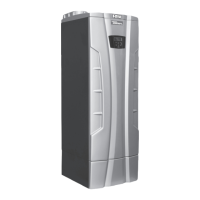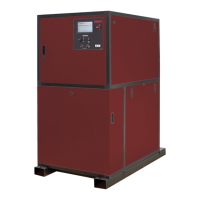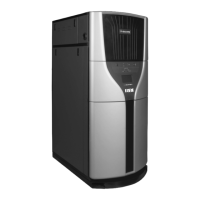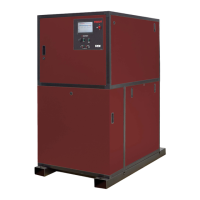nne
co
er tu
e gas
o
ers
water
eaters –
o
er
anua
31
NATU L GAS: Optimum results are obtained when the boiler/
water heater is operated with the manifold pressure(s) set per Table
19. e manifold pressure should not vary outside these ranges.
Each gas valve pressure regulator has been preset at the factory.
If adjustment is necessary the following steps must be followed:
1. Remove the 1/8" plug(s) from the manifold pressure valves.
Connect 20 in, 508 mm W.C. manometers to them, see Figure
18.
2. Remove the regulator adjustment screw cap from the safety shut
o valve(s).
3. Rotate the regulator adjustment screw clockwise to increase the
manifold pressure, counterclockwise to decrease it.
4. Replace the regulator adjustment screw cap and manual shut o
valve pressure tap plug.
Never force the regulator adjustment screw beyond
the stop limits or damage to the regulator will occur!
PROPANE GAS: Optimum results are obtained when the boiler/
water heater is operated with the manifold pressure(s) set per Table
19. If the manifold pressure is o by more than 5% adjust it according
to steps 1 through 4 above.
Air ow Adjustment
1. Remove the upper front jacket panel.
2. Connect both sides of a manometer to the pressure switch tee,
Figure 18, going to one of the pressure switches.
3. With the unit operating at high re the di erential pressure should
be between 0.6 and 0.8 in, 15 and 20 mm W.C. Do not change
air pressure in lower stages.
4. To ne tune the air se ings once the upper front jacket panel is
installed, remove the plastic plug(s) on the upper front jacket
panel. Use a Phillips screwdriver to rotate the screw(s) to obtain
the CO
2
and CO readings in the INPUT TE section above.
CONTROL DESCRIPTION
Boiler Thermostat
If a thermostat is to be used to control the boiler always follow the
instructions included with the thermostat. Proper location of the
thermostat will ensure e cient trouble-free operation of the boiler.
Mount the thermostat to an inside wall at a height approximately
ve feet above the oor.
Avoid placing the thermostat in areas that will not provide an accurate
measurement of the room temperature. Locating the thermostat
behind a door, in an alcove, close to a source of thermal radiation
or in a dra y area will cause poor or sporadic heating.
For a thermostat that employs an adjustable heat anticipator, adjust
the anticipator to match the current measured in the thermostat
circuit. An increased anticipator se ing may be necessary if the unit
cycles frequently. If the room temperature over-shoots the thermostat
se ing, reduce the anticipator se ing.
Operating Control
e preferred control se ing for potable hot water is 130°F, 54°C.
e operating control should be set to the lowest se ing that will
satisfy the consumer's needs.
Se ing the thermostat or operation control too high
can result in scalding resulting in severe personal injury!
High Limit (Aquastat)
e high limit is located in the le side area of the boiler/water
heater. A remote capillary bulb is run to a well on the outlet side
of the supply header. e high limit can be reset by depressing the
black rubber plug in the front top jacket panel.
e water heater high limit should be set a minimum of 20°F,
11°C higher than the operating control. Refer to the HOT WATER
SUPPLY section for the proper supply water temperature.
Flow Switch
A ow switch is provided in the water outlet piping to prevent the
boiler/water heater from ring without adequate water ow through
the heat exchanger.
Low Water Cuto
If the boiler is to be installed above radiation or if required by other
codes or regulations, install a low water cuto in appropriate piping.
Wire the switch and any external controls in series to the "Interlock"
contacts in the junction box (see the a ached Connection Diagrams
for details). Ensure that the low water cuto device(s) will function
properly.
Flame Sense Module
e ame sense module is located on the control tray. It is an
intermi ent pilot control device that controls the pilot gas ow,
spark energy to ignite the pilot gas and the main valve(s) once pilot
ignition has been proven.
Two ame failure alarm terminals are provided on the ame sense
module. For CSD-1, these terminals will be utilized to shut the unit
down in case of ame failure. e two terminals will be connected
to a lockout control module located on the control tray under the
ame sense module. is lockout control module contains a magnetic
latch relay that requires manual reset when de-energized. To reset
a er ame failure, push and release the momentary contact switch
located within the front control panel.

